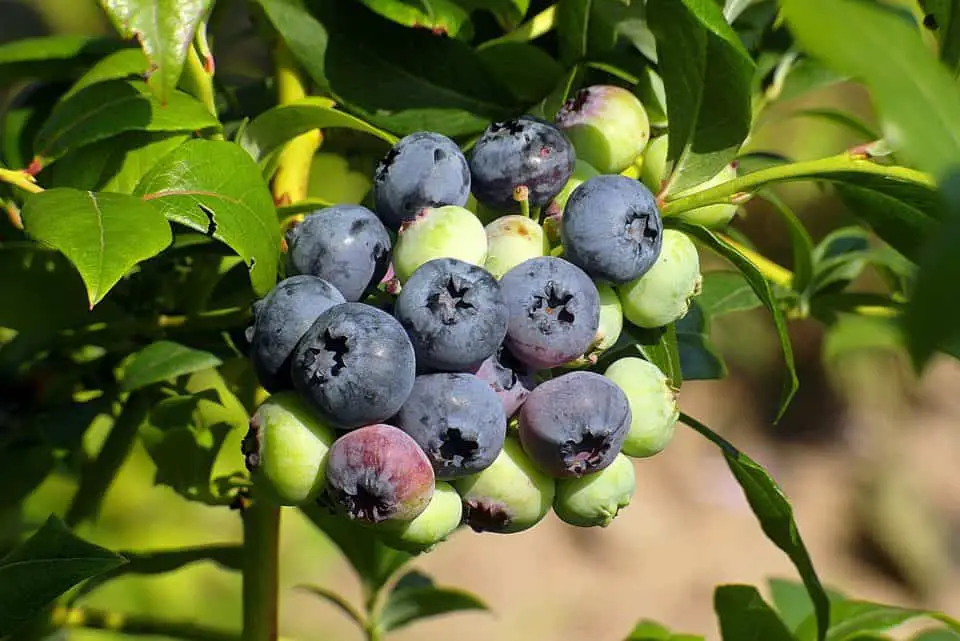Some links in the post are affiliate links and I get a commission from purchases made through some links found in the post.
Most people like blueberries- they taste great, have enough antioxidants to wow our doctors, and are beautiful.
So, it makes sense that we would want to have more of these fruits in our bellies. But are you tired of buying blueberries at the store?
How about waiting all year until the blueberry season to get some of that berry goodness? If this describes you, we have some good news!
You can plant blueberries in your home. Even in Texas! We’ve put together some critical factors you must note when growing blueberries in Texas.
Come next blueberry season, you’ll be plucking these berries from the comfort of your home.
How To Grow Blueberries in Texas
Growing blueberries in Texas is not as hard as you might think. All you need is to figure out the general conditions to grow blueberries and customize these to meet what you have in Texas.
Are you lost? Let’s break this down so you can see that it’s quite an easy task even for newbies:
Choose a Suitable Variety
 Blueberries come in different varieties suited for different USDA hardiness zones. They do well in zones 4 to 10. So, what would work in Texas? The best blueberries in Texas to use are the southern highbush varieties or the rabbiteye blueberries.
Blueberries come in different varieties suited for different USDA hardiness zones. They do well in zones 4 to 10. So, what would work in Texas? The best blueberries in Texas to use are the southern highbush varieties or the rabbiteye blueberries.
These work in zones 5 through 10 and are ideal for the warm climate in Texas. If you live in zones 5 to 10, favor the southern highbush options.
These should be at least 1.8 meters apart. You can use these varieties to make desserts or even eat them fresh.
For people in zones 8 to 10, go for the rabbiteye options. These high-heat blueberries should be at least 4.6 meters apart.
Keep this in mind as it affects how many of these you can fit on one lot. You might want to try the highbush varieties to save space.
Does spacing matter? Yes! Blueberries feature male and female organs and must cross-pollinate to ensure the production of berries.
Some of the plants cross-pollinate, but to be sure, ensure you get the spacing right. It also works to your advantage if you mix varieties- to better the odds, though this is not necessary.
Create a Conducive Environment
Blueberries need as much sunlight as they can get, especially when the fruit starts to develop.
So, how can you ensure that the blueberries get enough sunshine? By building a raised garden bed about four feet wide and 12 inches high.
The bed can be simple, held together by boards on the side. But to ensure that the bed holds up during the seasons, use wood that does not rot.
Are there spots on the land that are better than others? Sure! Avoid any damp areas or spots that do not have much sun access.
Also, locate the bed away from any shade that could interfere with access to the sun. Remember that the sun’s position will change through the seasons. Will the chosen spot still have good access to sunlight?
The plants can tolerate some shade, but if you can get a spot with full sun, that’s the better option.
Nourish the Soil
The soil must be well amended. Here’s one thing you want to be cautious about – root rot. Blueberries have shallow root systems.
So, if they sit in water for longer than they should, all your hard work could go to waste. Ensure that the soil is well-draining before you even think of amending the soil – it makes all the difference.
Of course, you also need to mind your watering schedule, but first, you must ensure that excess water can drain.
Should you amend the soil? Yes! Add some peat moss to encourage better drainage. Then test the pH of the soil. Blueberries do best in acidic soils with pH levels between 4 and 5.
You can enrich the soil with compost and planting mixes to increase the soil acidity. Once the pH level comes back within the 4 to 5 range, you can move on to the planting stage.
That’s all you need- no frills, no backbreaking fertilization- just the simple stuff. You can fertilize the soil later after planting the blueberries.
Plant the Blueberries
You are better off using blueberries at least two years old as this reduces the time taken to fruit.
But you can also go with younger plants if you are not in a rush to start eating the fruits. Plant the blueberries in shallow holes, ensuring that the top of the root base is about an inch above the ground.
Then pat the top of the plant to cover the exposed roots. Water the plants thoroughly with one to two inches of water a week. Remember that they have shallow roots, so do not drown them.
You may also like: how much sun does lettuce need
When Can I Plant Blueberries in Texas?
 Good question! It depends on where you plant the blueberries. Suppose you want to plant the blueberries in the ground.
Good question! It depends on where you plant the blueberries. Suppose you want to plant the blueberries in the ground.
You should do so late in the season. Preferably, do this between fall and the end of winter. Keep the spacing in mind based on the blueberry variety.
If you plant the blueberries in controlled conditions, you can do so at any time of the year. The general rule of thumb is that the fruits will ripen towards the end of summer- just in time for desserts.
How Well Do Blueberries Grow in Texas?
If you choose the suitable varieties for your hardiness zone, the blueberries should do well in Texas.
We advise that you plant rabbiteye and southern high bush varieties as these do well in warm climatic regions and can thrive in Texas.
How To Grow Blueberries in Containers in Texas
Do you want to grow blueberries in a pot? It’s not that different from doing so in the ground. First, you need to find a compact variety suited for your specific hardiness zone.
Then choose a pot almost the same size as the plant, ensuring it has enough drainage holes. Add an acidic potting mix to the pot and plant the blueberry in the middle of the pot.
Ensure that you bury the plant’s crown, and you will be good to go. Follow through with watering the soil such that the excess water drains from the holes.
You can now place the pot in an area that receives at least six hours of sunlight a day.
Where Is the Best Place to Plant Blueberry Bushes?
Blueberries are best grown outdoors, seeing as they prefer full sun. However, they can tolerate partial shade.
Keep in mind that shaded plants produce much smaller berries, which can rob you of the joy of a fruitful harvest.
But if you live in a region where the sun is unbearable, you may want to shade the plant a bit to protect it from drying out.
How Long Does a Blueberry Bush Take to Grow?
 A bush should take ten years to reach a mature size. But if you get a young plant aged three or so, you can cut back on this waiting time.
A bush should take ten years to reach a mature size. But if you get a young plant aged three or so, you can cut back on this waiting time.
Of course, fast maturity also owes to providing the plant with all its growing requirements. If you think that the progress is minimal, you can apply fertilizer to the soil.
Do not use fertilizer in the first year, and in subsequent years, use fertilizer suited for acid-loving plants.
Are you ready for your next big harvest? As much as blueberries need a lot of water, be careful not to drown the plants. Happy Gardening!
Before you go, here are some more related articles I encourage you to read below to help solve more of your gardening issues:
How to Plant Blueberries in Oregon
Can You Grow Carrots Hydroponically
How Often Should you Water Cilantro


